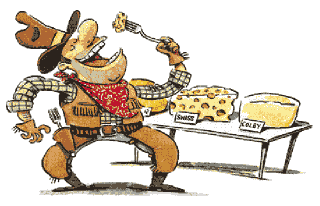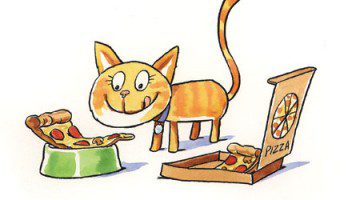By Lisa Ann Jackson
 The room is hushed except for the sounds of rumination. With six products to test and only 35 minutes allotted for each product, concentration levels are high. The competitors pull out triers–cylindrical blades that allow them to quickly yank a plug from a 40-pound block of cheese–and begin reaching for samples. Some keep their triers tucked in leather holsters at their hips, ready for a quick draw in the timed competition.
The room is hushed except for the sounds of rumination. With six products to test and only 35 minutes allotted for each product, concentration levels are high. The competitors pull out triers–cylindrical blades that allow them to quickly yank a plug from a 40-pound block of cheese–and begin reaching for samples. Some keep their triers tucked in leather holsters at their hips, ready for a quick draw in the timed competition.
BYU’s cheese tasters carry their triers in their pockets. But that doesn’t mean they are not contenders in the annual dairy product evaluation competitions. Indeed, with their sensory acuity and dairy-defect savvy, BYU’s dairy product evaluation team beats out many a leather-holstered crew. This year BYU students brought home individual first-place honors in cheddar cheese testing and second-place team honors in cottage cheese and butter, beating out the North Dakota State Bison and Mississippi State Bulldogs, teams that usually dominate the national competition. BYU also brought home other individual awards and took fourth place overall.
“There is a real culture to this contest. It has a tradition, and it’s really prestigious to win it,” says Lynn V. Ogden, associate professor of food science at BYU and coach of the dairy products evaluation team. “There are five or six schools who have dominated over the years, so we feel really good when we bring home a fourth place.”
At BYU, dairy product testing could be considered an extramural sport. It’s not a class, though students may get some academic credit for participating. They compete against teams from universities around the world, and they receive serious training in sensory evaluation that will aid them in industry when they leave BYU. They also get to mingle and network with the industry professionals who sponsor the competitions.
“Our students are going to use these skills to solve problems when they are out there in product development and quality assurance in the food industry,” says Ogden, who is also the chair of BYU’s Department of Food Science and Nutrition. “And the value of being able to make those connections with industry people is great. The professionals know that BYU is a serious institution educating students in these skills.”
At the regional and national contests held each October, participants test cheddar cheese, butter, ice cream, yogurt, milk, and cottage cheese. Using descriptors like “rancid,” “fermented/ fruity,” “pasty,” and “ropy,” these students evaluate each product’s appearance, body, and texture, and then pop samples (even the butter) into their mouths for the ultimate test. But they usually don’t swallow–they just grab a sample, stick it in, mull it over, and spit it out.
“It’s still kind of an ‘old boys art,'” says David B. McMullin, a senior from Bountiful, Utah, majoring in food science and economics. “There are things you can tell about a product using your senses that you can’t really quantify using instrumentation.”
One of those things is light-oxidized milk–milk that has been exposed to too much light and therefore develops a flavor insiders call “turkey feathers.” Ogden always pulls his gallons from the back of the grocery-store shelf to avoid the problem. Another defect is the taste of onion in milk or butter, which indicates that the cow dined on onion plants in the field. Other imperfections are ice shards on ice cream and lumps in yogurt.
“Most Americans are very accustomed to defective products,” says McMullin. “Most people taste them so often that they are used to them.”
To help team members learn to recognize defects, Ogden and a graduate assistant train the team for several months prior to competition. Starting in June, they spend three to four hours a week testing dairy products that have been carefully selected, and in some cases doctored, by the graduate assistant. By game time in October, the team is thoroughly prepared for the rigors of competition.
“You probably wouldn’t think of it as being a very grueling experience, but it is,” says McMullin, who won the contest’s first Joe Larson Merit Award for his evaluation skills and an essay. “You get sensory overload and sensory fatigue.”
“It’s more difficult than taking the GRE because of the sensory overload,” adds Jason Anderson, a food science graduate student from Mesa, Ariz., and assistant to Ogden for the 1998 and 1999 teams.
BYU has trained testing teams almost every year since 1967, but team members admit they are something like the Hoosiers of dairy product evaluation–lacking leather holsters for their triers and semester-long course work in dairy product evaluation. But they don’t feel much like underdogs.
“It would help us to be able to spend more time preparing,” says Ogden. “Then we could edge out North Dakota State and Mississippi State and Wisconsin. But we are up there with them now.”
“We used to fear them, now we taught them,” says Anderson.









